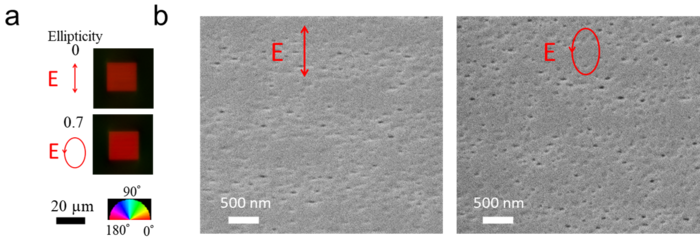One of the most significant manifestations of the light-matter interaction in nature is photoexcitation, particularly photoionization. This varies from photosynthesis in plants and vision in biology to photography and laser processing of materials.

a. Birefringence images of laser patterns written in silica glass with linearly and elliptically polarized pulses. b. Scanning electron microscope (SEM) images of corresponding nanopore structures. Image Credit: by Yuhao Lei, Gholamreza Shayeganrad, Huijun Wang, Masaaki Sakakura, Yanhao Yu, Lei Wang, Dmitrii Kliukin, Linards Skuja, Yuri Svirko, and Peter G. Kazansky.
Normally, it is accepted that the change in a substance is weaker if less light has been absorbed. In this context, it is discovered that this is not always the case.
In a new study reported in the journal Light Science & Application, a research group headed by Professor Peter G. Kazansky from Optoelectronics Research Center, University of Southampton, United Kingdom, and co-workers have illustrated effective ultrafast laser nanostructuring along with elliptical polarization in silica glass.
In opposition to intuition, despite the nonlinear absorption being around 2.5 times weaker, elliptically polarized pulses lead to nearly twice the birefringence of linearly polarized light. Anisotropic nanopores having a greater concentration are noted with elliptically polarized pulses.
The phenomenon has been interpreted concerning improved interaction of circularly polarized light having a network of randomly oriented bonds and hole polarons in silica glass, and also effective tunneling ionization of defects with low excitation potentials by circular polarization.
“It is commonly believed that the multiphoton ionization dominates in ultrafast laser writing in transparent materials, but we revealed that tunneling excitation of laser-induced defects, such as self-trapped holes, is a key for nanostructuring in silica glass” the scientists added.
“In 5D optical data storage, information can be recorded by elliptically polarized pulses with lower energy and higher writing speed. Moreover, our demonstration allows production of large area geometric phase optical elements and vector beam converters with ultrahigh transmittance for high power and UV lasers.” they forecast.
Journal Reference
Lei, Y., et al. (2023) Efficient ultrafast laser writing with elliptical polarization. Light Science & Applications. https://doi.org/10.1038/s41377-023-01098-2.